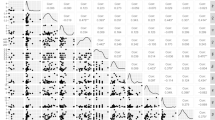Play all audios:

ABSTRACT Summary: A low-molecular-weight zinc-binding ligand from human milk has been isolated and characterized. The ligand was isolated by chromatography on Dowex 50, Dowex 1, and Sephadex
G-15 equilibrated with 0.153 mM Zn(NO3)2. Mass spectroscopy, thin-layer chromatography, and infrared spectroscopy proved that the zinc-binding ligand isolated by this method from human milk
is pyridine-2-carboxylic acid, commonly known as picolinic acid. The concentration of picolinic acid in human milk was 308 μM, the concentration in one brand of processed cow's milk
was 20 μM, but picolinic acid was undetectable in a second brand of cow's milk and in four different infant formulas. Weanling rats fed supplemental picolinic acid absorbed
significantly more dietary zinc and gained significantly more weight than rats fed an unsupplemented diet. The results suggest that the high bioavailability of zinc in human milk results
from the presence of picolinic acid, a bidentate chelating ligand which facilitates zinc absorption from the intestine. Speculation: The high bioavailability of zinc in human milk results
from the presence of picolinic acid, a bidentate chelating ligand which facilitates zinc absorption from the intestine. SIMILAR CONTENT BEING VIEWED BY OTHERS ESSENTIAL AND NON-ESSENTIAL
ELEMENT CONCENTRATIONS IN HUMAN MILK SAMPLES AND THE ASSESSMENT OF INFANTS’ EXPOSURE Article Open access 07 April 2024 ASSESSING THE DEGRADATION OF ANCIENT MILK PROTEINS THROUGH
SITE-SPECIFIC DEAMIDATION PATTERNS Article Open access 08 April 2021 DIFFERENTIAL SCANNING FLUORIMETRY TO ASSESS PFAS BINDING TO BOVINE SERUM ALBUMIN PROTEIN Article Open access 18 March
2024 ARTICLE PDF AUTHOR INFORMATION AUTHORS AND AFFILIATIONS * United States Department of Agriculture, Science and Education Administration, Human Nutrition Laboratory, Grand Forks, North
Dakota, USA Gary W Evans & Phyllis E Johnson Authors * Gary W Evans View author publications You can also search for this author inPubMed Google Scholar * Phyllis E Johnson View author
publications You can also search for this author inPubMed Google Scholar RIGHTS AND PERMISSIONS Reprints and permissions ABOUT THIS ARTICLE CITE THIS ARTICLE Evans, G., Johnson, P.
Characterization and Quantitation of a Zinc-Binding Ligand in Human Milk. _Pediatr Res_ 14, 876–880 (1980). https://doi.org/10.1203/00006450-198007000-00007 Download citation * Issue Date:
01 July 1980 * DOI: https://doi.org/10.1203/00006450-198007000-00007 SHARE THIS ARTICLE Anyone you share the following link with will be able to read this content: Get shareable link Sorry,
a shareable link is not currently available for this article. Copy to clipboard Provided by the Springer Nature SharedIt content-sharing initiative KEYWORDS * acrodermatitis enteropathica *
human milk * picolinic acid * zinc
